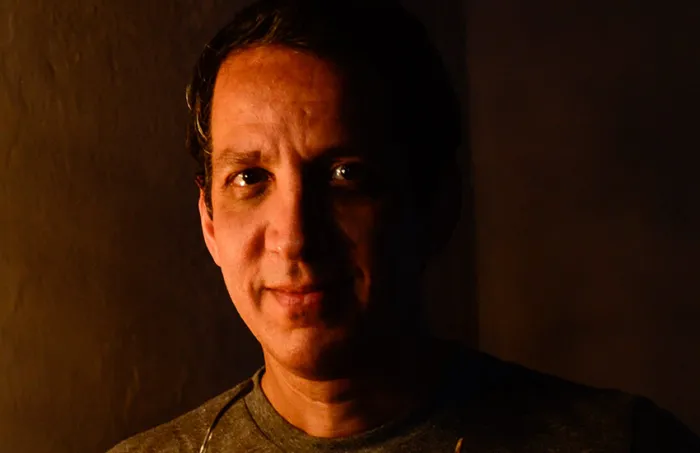I am Gregor Samsa, so are you

A sliver of light enters a room bringing with it the silhouette of a wide-framed man. With startled limbs and hollow eyes, a black bug stares at the imposing intruder. On opening Peter Kuper’s adaptation of The Metamorphosis, one finds these words in white set against two stark black pages: When Gregor Samsa awoke one morning from disturbing dreams, he found himself transformed…
Readers of Franz Kafka’s The Metamorphosis have for years imagined what kind of bug Gregor would’ve turned into. This graphic novel just gave away the answer in the cover itself. “One of the things I really wanted to do was to have a sort of butter paper jacket cover that showed fuzzy images and shapes but didn’t fully reveal how Gregor looked. So if the reader wanted to know, he’d have to open the jacket or start reading the book. But the publishers didn’t conceptually understand the importance of not revealing Gregor so quickly to the reader,” sighs Kuper. Reading Kuper’s The Metamorphosis the first time around is not an easy experience for the literary reader. For most of them Kuper was treading on sacred territory.
Kuper opens the book with a panel of Gregor lying on his back, staring at a familiar room. The saliva trickling from his mouth and onto his pillow indicates that it has only been a few minutes since he awoke. His favourite picture of the woman in fur is framed and rests against the wall near his suitcase of overflowing fabrics. The first image of Gregor in his room is almost identical to Kafka’s original description in The Metamorphosis.
The American alternative cartoonist and illustrator was fully aware of the harsh lens under which literature lovers have viewed his book. People tend to dislike a newer version of something they’ve grown to admire. “Who is this man tampering with Kafka? How dare he? I know people had thought of my book like that before they read it. It’s natural. Personally I didn’t get around to thinking too hard or I wouldn’t have done it. I went with my instinct.”
The first reading of the book tends to be limited to skimming through it to compare larger issues and ideas with the original work. On reading the book a second time, we find ourselves noticing how Gregor has shaped up in Kuper’s interpretation. In the way that Gregor is depicted, in stark black and white, it appears that Kuper wanted to draw upon the loneliness and despair present in so many of Kafka’s stories, including The Metamorphosis. Kafka never definitively told readers exactly what kind of insect Gregor was transformed into. In the narrative it is left to the reader’s imagination to picture Gregor’s struggles in his new body and suddenly gigantic surroundings. “My understanding of Gregor was that he was a sensitive, sympathetic man with a sense of humour. I wanted to create a Gregor that you, the reader would feel for. He’s struggling along with his life, has trouble with his father and a difficult, evolving relationship with his sister.”
Working so closely on the characters and the story can be exhausting. When Kuper started work on the book one winter, he felt comforted by the gloomy and black and white nature of the comic. By the time summer came, he started to feel the weight of working on The Metamorphosis. While the process was exhausting, Kuper was happy to draw inspiration from his family for shaping up the characters. “You start to place yourself in the context of your characters. I was having an intimate relationship with Gregor. His sister was like my sister. His mom was in the range between my mother and grandmother. His father wasn’t like mine, but he was the concept of a father figure that I have seen. I worked at manic pace sometimes while creating the characters. It was almost like the Ghost of Kafka was whispering in my ear.”
The Metamorphosis though is not the first time Kuper attempted to recreate Kafka’s magic in panels. Give It Up!, comics adaptation of Franz Kafka short stories was released in 1995, eight years before The Metamorphosis. And it was an eight year long process of putting it together. Kuper used the technique and experience of Give It Up! as the preparation for his work in The Metamorphosis. He was going to make every effort to win over the toughest sceptic. After reading Kuper’s version a few times and growing tired of comparing his story with Kafka’s, we finally let ourselves look at the book in isolation. And that is when the artwork truly stand outs.
Adopting a hybrid of German woodblock-print style and detailed inking, his artwork is also heavily influenced by R. Crumb’s Kafka that was published in 1993. Robert Crumb, highly respected in the alternative comics milieu, had created an illustrated biography of Kafka that included portions of The Metamorphosis. Kuper has been a fan of German Expressionism and cites Lynd Ward, a pioneer in woodcut wordless novels as an influence. “I was doing that kind of stuff in the 80s and it got codified with the Kafka material.”
Kuper narrates the story by writing the text on different objects, whether it’s a desk, a piece of clothing, or Gregor’s back. Kuper’s illustrating style is almost aggressive. It’s scratchy, sharp, and has the effect of making everything seem very bleak. With the exception of the flashback panels that have softer edges, the panels are very angular and bold. Kuper gives each character a different speech bubble that helps the reader to imagine what they sound like. For example, Gregor’s boss’ speech is contained within perfect rectangles and squares with a straightforward sans serif font. This shows that what he is saying is important and that he’s not about to accept any excuses or nonsense from Gregor. Gregor’s speech, on the other hand, is contained within squiggly bubbles and the font is shaky and looks as if a child wrote it.
Kafka used humour to transform the story of someone losing his head into a bewitching story. “Kafka laid it all out for us artists. He wouldn’t have approved of our work anyway. He wanted his own writings to be burnt. But he left us with such vivid descriptions and crazy plots. A man turns into a bug or a bridge. That one sentence is strong enough to turn into a comic book. The Metamorphosis is such a hit because it deals with universals themes with a great dose of humour. It is deeply emotional but it appears simple.”
Kuper has dedicated the book to “The Gregor Samsas everywhere”. Who then is Gregor Samsa? “I am Gregor Samsa. So are you. At different times. Sensitive people who face the challenges life throws their way. There’s a Gregor everywhere. I can identify with him tremendously. Everybody feels trapped some time or the other with life, family issues, etc. They experience a sense of isolation, the fear of dying alone… but Kafka put the humour in to make it easy for us. We don’t always have that happen in our lives.”






